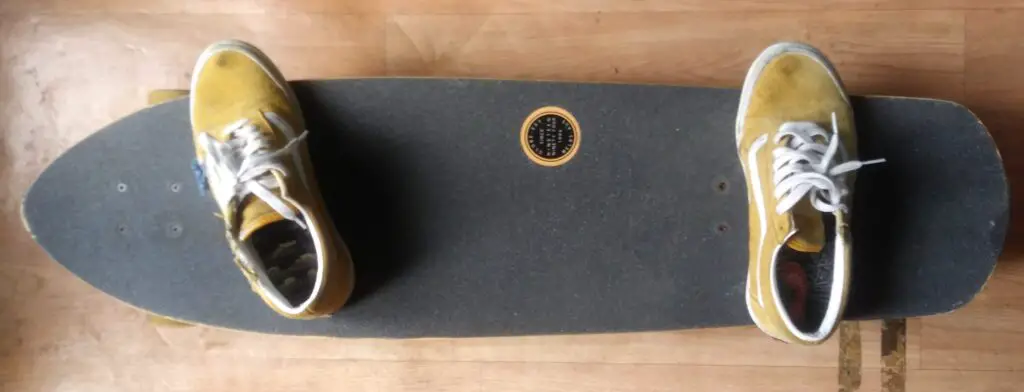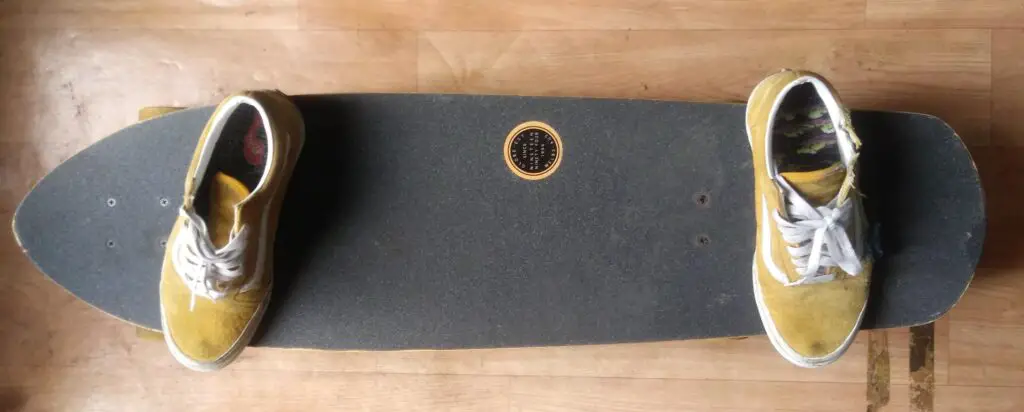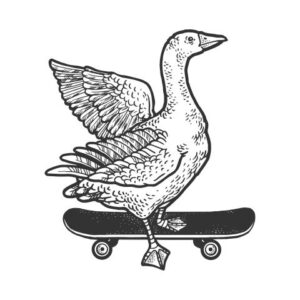Longboards are large boards that sort of look like a surfboard, but with wheels on them.
There are designed to be large enough to balance easily and easily cruise over small obstacles such as cracks and small debris. They have large and soft wheels to help give a smooth ride.
Despite being designed for a stable ride, pushing on your longboard can be a bit difficult at first. It is literally a board on wheels!
So there is a proper way to push a longboard so let’s get right into it.
How to Push on Your Longboard
1. Step Onto Your Longboard
Even just balancing on your longboard is difficult for some people, but the idea is to keep your feet at least shoulder-width apart and distribute your weight between both feet. You should have your center of gravity approximately over the center of the board and between your feet.
Step onto the board with your front foot first near the front bolts of the board. Then bring your back foot on near the back of the board. Once your back foot is on the board, shift some of your weight so your weight isn’t all on one foot.
2. Center Your Front Foot
Now, before you actually push off and get going there is something important to consider and that is your front foot. Your front foot needs to be balanced in the very middle of your front bolts. If your front foot is slightly situated to the left then you will turn to the left when you push and vice versa.
Not centering your front foot is probably the most common reason why people have trouble controlling their board when pushing. You need to make sure that the force of your push will make your longboard go straight forward and not off to the side somewhere. This will take some practice to get a feel for, but after many hours of practice, you will do this naturally.
Also, be aware that your front foot will be facing so your toes are toward the front of the longboard. This will help you push more naturally, and you will turn your front foot after the push has been completed.
If you aren’t sure whether you should get a longboard or a skateboard, check out my complete guide to choosing the right board based on your desired riding style.
3. Use Your Back Foot to Push Forward
Tilt your chest forward and bring your back foot down against the pavement while sweeping it back so you are pushed forward. The more force you give, the faster you will be pushed forward.
It will take time to learn this motion smoothly so the best thing to do is get lots of practice. Try riding your longboard around your city for a few hours each week. I personally love to do this type of cruising with a friend. Try and get a beer and dinner after.
Learning the push-off will come quite quickly. I take beginners out to longboard quite often and most of them can push off and ride along in a single afternoon. Not all of them, but the majority can.
4. Bring Your Back Foot Onto the Longboard
After you have pushed off with your back foot and are moving forward you can either push off the ground one more time or bring your back foot onto your longboard again.
Simply put your back foot back onto the tail of your board and reshift some of your weight so that it is distributed between both feet again. Your center of gravity should be between your feet and centered above your moving board.
Your back foot should be roughly perpendicular to your board.
5. Turn Your Front Foot Perpendicular to The Longboard
After your back foot is on the longboard again and you have shifted your weight, you might notice that it will feel strange to have the front foot face forward still. You can’t turn the board well in this position and your body will want to naturally open up on the board.
It is at this time that you will shift your front foot about 90 degrees so that it is perpendicular to the longboard. This will give you better control of the board while moving and you’ll be able to easily carve and turn. This will be your natural riding position.
Before you want push again, you will again shift your front foot so it is parallel to your board (toes pointing towards the front of the board). Be aware that as you push, your front foot will keep switching positions from facing the front of the board back to being perpendicular to the skateboard. It will take time to do this smoothly and naturally, but practice does wonders.
Don’t worry about practicing the best way or about any clumsy awkward things you do while skating. Just focus on spending time riding your longboard. Everything else will follow.
If you are wondering if longboarding will help you get fit and lose weight or not, check out my guide to using longboarding as exercise with a calorie calculator!
Longboarding Pushing Styles
They’re really just a couple of pushing styles out there. Regular and goofy are the big two and which one you do is simply determined by your stance. Switch is also a term used to describe riding in your non-natural stance but is mostly used for skateboarding and not longboarding.
Anyway, let’s go over them.
Regular

Having a regular stance refers to having your left foot as your front foot and your right foot as your back foot. Your body will face to the right of your longboard as you ride.
This is considered the default stance and most people skate in a regular stance. It’s kind of like being right-handed in skateboarding and longboarding. Pushing is done with your right foot.
Goofy

Goofy stance refers to having your right foot as your front foot and your left foot as your back foot. Your body and chest will face to the left of your longboard as you ride.
This stance is less common and is kind of like being left-handed in skateboarding and longboarding. It’s still pretty common though. One of my favorite skaters, Andy Anderson, rides goofy for instance.
Pushing is done with your left foot.
Switch
Switch just refers to riding in your non-normal stance. So if you usually ride in a regular stance, then switch for you is riding goofy.
While skateboarding learning to ride switch is important, but not so much for longboarding. Most longboarders simply cruise around or use their longboard for transportation and commuting. You might need to learn to ride in a switch stance if you are trying to learn freestyle tricks with your longboard because then you might switch stances during a trick.
Otherwise, don’t worry about it.
Learn all about longboarding history and other interesting tidbits for trivia night while reading my 25 Interesting and Stats and Facts About Longboarding article!
Additional Questions
How Do I Push My Longboard Without Falling?
No one wants to fall while longboarding. Luckily pushing off is pretty easy to learn and once you know how to push off, you likely will rarely fall while pushing again.
Pushing your longboard without falling will take some practice and time. The most common problem that new riders have while pushing their longboard is not properly centering their front foot. If your front foot is not properly centered then your longboard will turn as you push and you will fall off or step off of your board.
It takes time and practice to build up the muscle memory needed for good longboarding form. So practice, practice, and then practice some more. Just focus on spending more time riding your longboard and results will come naturally.
What Foot Do I Use to Push My Longboard?
There isn’t exactly a right or wrong foot to use to push off.
The foot that you use to push your longboard depends on the riding stance used. Generally, though, the back foot will be used to push and the front foot will remain on the board at all times to help steer. The choice of which foot is your front and back foot is a matter of choice. Most riders put their left foot towards the front of the board and use their right foot to push off.
The only incorrect thing you can do is use your front foot to push off. Doing so will make it so controlling your board is difficult and your board will likely start to turn on its own. Always use your back foot to push your longboard.
Can I Push My Longboard With My Front Foot?
You basically never see someone push a longboard with their front foot and for good reason.
Pushing a longboard with your front foot is not good form and will make it hard to control your longboard. At higher speeds, this can also be quite dangerous. The front of the longboard determines the direction of motion of the board. If there is no foot controlling it, it can suddenly turn and cause the rider to crash into the ground or fall off.
I wouldn’t recommend actually trying to do this. There’s no good reason to even try to push with your front foot and there are plenty of reasons why not to try this.
If you are wondering exactly how dangerous longboarding is, check out my complete guide with statistics about longboard injuries and safety tips.
Additional Resources
Below is a great little video guide that goes over skateboarding as an adult and the different aspects. I linked it because it applies to longboarding just as well. I also linked it so that the video starts right when he goes over foot position and actually stepping on and pushing off with your board.
Honestly, I love how down-to-earth the guy is so go support his Youtube channel.
Conclusion
So that’s it.
Pushing off can seem like a daunting first step, but you’ll get it in no time. I often take new skaters cruising with me and many people learn to push off in literally just an afternoon. If it takes you longer than most people, don’t be discouraged. Everyone learns at their own pace.
Make sure you focus on good form and just practice as much as possible. Stop reading this and go ride your longboard!
Anyway, I hope this guide helped you in some way. Thanks for reading, and look out for more content from Board and Wheels.



